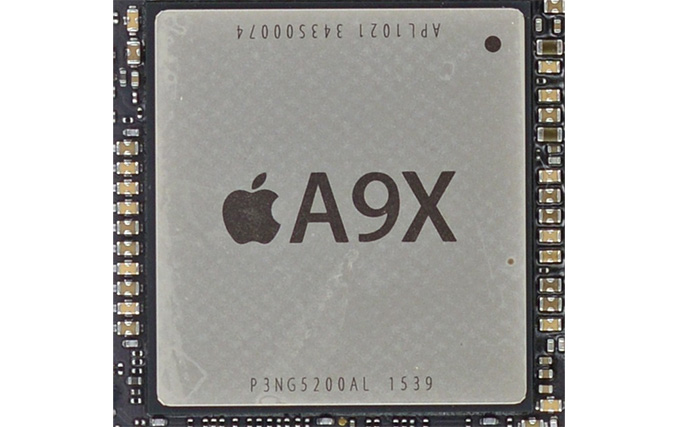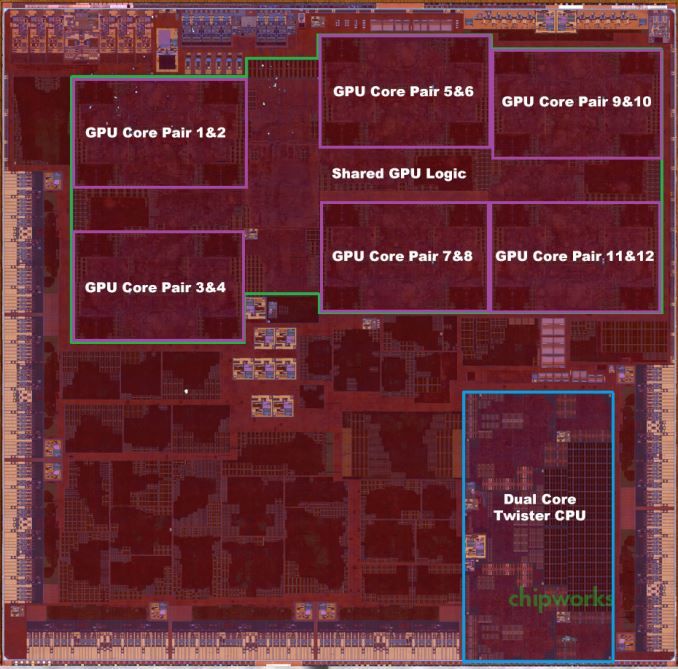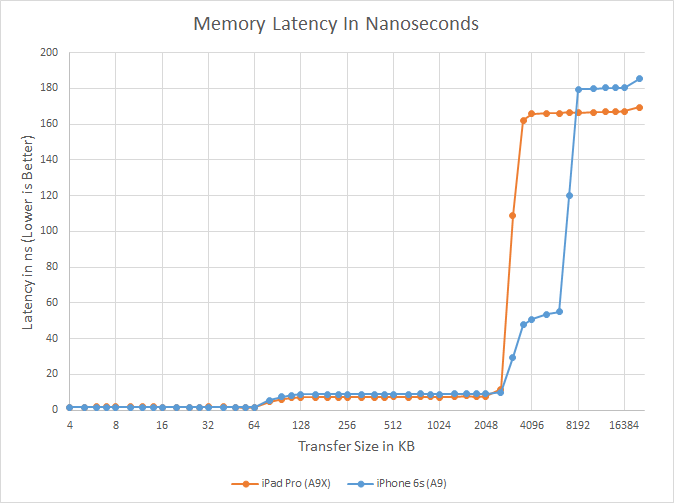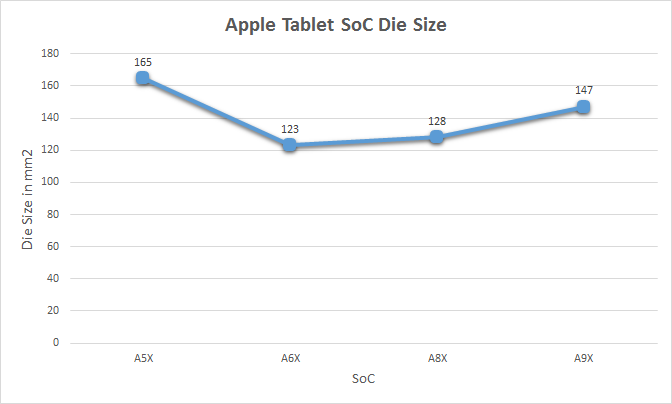The Apple iPad Pro Review
by Ryan Smith, Joshua Ho & Brandon Chester on January 22, 2016 8:10 AM ESTSoC Analysis: Apple A9X
Diving into the heart of the iPad Pro, we have Apple’s latest generation tablet SoC, A9X. Like the other Apple X series SoCs before it, A9X is by and large an enhanced and physically larger version of Apple’s latest phone SoC, taking advantage of the greater space and heat dissipation afforded by a tablet to produce a more powerful SoC.

Apple's A9X (Image Courtesy iFixit)
That Apple has developed a new SoC to launch alongside the iPad Pro is in no way surprising, but just as how the iPad Pro has ramifications for the overall iPad lineup as Apple gets into the productivity tablet market, iPad Pro’s genesis is reflected in its component selection. Apple already needed a powerful SoC for the iPad Air 2 in order to keep performance up with the tablet’s high resolution of the screen, and iPad Pro in turn pushes Apple’s performance needs even harder. Not only is there an even higher resolution screen to drive – the 2732x2048 display has about 66% of the pixels of a 4K display – but now Apple needs to deliver suitable performance for content creation and meaningful multitasking. I don’t want to imply that the A9X was somehow specifically designed from scratch for the iPad Pro, as there are a number of more important engineering considerations, but I do want to highlight how the iPad Pro is not just another iPad, and that as Apple expands the capabilities of the iPad they need to expand the performance as well if they wish to extend their reputation for smooth UX performance.
Looking at the specifications of the A9X, it seems like Apple always throws us a curveball on the X series SoCs, and for their latest SoC this is no different. With A8X Apple delivered more RAM on a wider memory bus, a larger GPU, and surprisingly, three Typhoon CPU cores. To date it’s still not clear just why Apple went with three CPU cores on A8X – was it for multitasking, or as an alternative means to boost performance – and A9X’s configuration only serves to highlight this enigma.
| Apple SoC Comparison | ||||||
| A9X | A9 | A8X | A6X | |||
| CPU | 2x Twister | 2x Twister | 3x Typhoon | 2x Swift | ||
| CPU Clockspeed | 2.26GHz | 1.85GHz | 1.5GHz | 1.3GHz | ||
| GPU | PVR 12 Cluster Series7XT | PVR 6 Cluster Series7 (PVR GT7600) |
PVR 8 Cluster Series6XT (APL GXA6850) |
PVR SGX554 MP4 | ||
| RAM | 4GB LPDDR4 | 2GB LPDDR4 | 2GB LPDDR3 | 1GB LPDDR2 | ||
| Memory Bus Width | 128-bit | 64-bit | 128-bit | 128-bit | ||
| Memory Bandwidth | 51.2GB/sec | 25.6GB/sec | 25.6GB/sec | 17.1GB/sec | ||
| L2 Cache | 3MB | 3MB | 2MB | 1MB | ||
| L3 Cache | None | 4MB | 4MB | N/A | ||
| Manufacturing Process | TSMC 16nm FinFET | TSMC 16nm & Samsung 14nm |
TSMC 20nm | Samsung 32nm | ||
Instead of continuing with a triple-core CPU design for A9X, for their latest X series SoC Apple has dropped back down to just a pair of Twister CPU cores. The catch here – and why two cores is in many ways better than three – is that relative to A8X and A9, Apple has cranked up their CPU clockspeeds. Way, way up. Whereas the iPad Air 2 (A8X) shipped at 1.5GHz and the iPhone 6s (A9) at 1.85GHz, the A9X sees Apple push their clockspeed to 2.26GHz. Not counting the architectural changes, this is 22% higher clocked than the A9 and 51% higher than the A8X.
The fact that Apple dropped back down to 2 CPU cores is unexpected given that we don’t expect Apple to ever go backwards in such a fashion, and while we’ll never know the official reason for everything Apple does, in retrospect I’m starting to think that A8X was an anomaly and Apple didn’t really want a tri-core CPU in the first place. A8X came at a time where Apple was bound by TSMC’s 20nm process and couldn’t drive up their clockspeeds without vastly increasing power consumption, so a third core was a far more power effective option.

A9X Die Shot w/AT Annotations (Die Shot Courtesy Chipworks)
Overall this means that iPad Pro and A9X will set a very high bar for tablet CPU performance. As we’ve already seen in the iPhone 6s review, the Twister CPU core is very potent and in most cases faster than any other ARM CPU core by leaps and bounds. Cranking up the clockspeed a further 22% only serves to open up that gap even further, as Twister is now reaching clockspeeds similar to the likes of Cortex-A57 and A72, but with its much wider execution pipeline and greater IPC. This is also the reason that an Intel Core CPU comparison is so interesting, as Intel’s tablet-class Core processors in many ways are the target to beat on overall CPU performance, and we’ll be touching upon this subject in greater detail a bit later.
GPU: Imagination PowerVR 12 Cluster Series 7XT
Meanwhile on the GPU side, as expected Apple has further increased the number of clusters on their SoC to drive the higher resolution display of a tablet. Whereas A9 used a 6 cluster design (PVR GT7600), A9X doubles this, giving us a relatively massive 12 cluster design.
In Imagination’s PowerVR Series7XT roadmap, the company doesn’t have an official name for a 12 cluster configuration, as this falls between the 8 cluster GT7800 and 16 cluster GT7900. So for the moment I’m simply calling it a “PowerVR 12 cluster Series7XT design,” and with any luck Imagination will use a more fine-grained naming scheme for future generations of PowerVR graphics.
In any case, the use of a 12 cluster design is a bit surprising from an engineering standpoint since it means that Apple was willing to take the die space hit to implement additional GPU clusters, despite the impact this would have on chip yields and costs. If anything, with the larger thermal capacity and battery of the iPad Pro, I had expected Apple to use higher GPU clockspeeds (and eat the power cost) in order to save on chip costs. Instead what we’re seeing is a GPU that essentially offers twice the GPU power of A9’s GPU.
However to put all of this in context, keep in mind that iPad Pro’s display is 5.95Mpixels, versus the 2.07Mpixel screen on the iPhone 6s Plus. So although Apple has doubled the number of GPU clusters for A9X – and I suspect clocked it fairly similarly – that increased performance will be very quickly consumed by the iPad Pro’s high resolution screen. Consequently even a 12 cluster GPU design is something of a compromise; if Apple wanted to maintain the same level of GPU performance per pixel as in the iPhone 6s family, they would have needed an even more powerful GPU. Which just goes to show how demanding tablets can be.
Memory Subsystem: 128-bit LPDDR4-3200, No L3 Cache
Responsibility for feeding the beast that is A9X’s GPU falls to A9X’s 128-bit LPDDR4 memory controller configuration. With twice as many GPU clusters, Apple needs twice as much memory bandwidth to maintain the same bandwidth-to-core ratio, so like the past X-series tablet SoCs, A9X implements a 128-bit bus. For Apple this means they now have a sizable 51.2GB/sec of memory bandwidth to play with. For an SoC this is a huge amount of bandwidth, but at the same time it’s quickly going to be consumed by those 12 GPU clusters.
| Geekbench 3 Memory Bandwidth Comparison (1 thread) | ||||||
| Stream Copy | Stream Scale | Stream Add | Stream Triad | |||
| Apple A9X 2.26GHz | 20.8 GB/s | 15.0 GB/s | 15.3 GB/s | 15.1 GB/s | ||
| Apple A8X 1.5GHz | 14.2 GB/s | 7.44 GB/s | 7.54 GB/s | 7.49 GB/s | ||
| A9X Advantage | 46.4% | 101% | 103% | 102% | ||
It’s also while looking at A9X’s memory subsystem however that we find our second and final curveball for A9X: the L3 cache. Or rather, the lack thereof. For multiple generations now Apple has used an L3 cache on both their phone and tablet SoCs to help feed both the CPU and GPU, as even a fast memory bus can’t keep up with a low latency local cache. Even as recent as A9, Apple included a 4MB victim cache. However for A9X there is no L3 cache; the only caches on the chip are the individual L1 and L2 caches for the CPU and GPU, along with some even smaller amounts for cache for various other functional blocks..
The big question right now is why Apple would do this. Our traditional wisdom here is that the L3 cache was put in place to service both the CPU and GPU, but especially the GPU. Graphics rendering is a memory bandwidth-intensive operation, and as Apple has consistently been well ahead of many of the other ARM SoC designers in GPU performance, they have been running headlong into the performance limitations imposed by narrow mobile memory interfaces. An L3 cache, in turn, would alleviate some of that memory pressure and keep both CPU and GPU performance up.
One explanation may be that Apple deemed the L3 cache no longer necessary with the A9X’s 128-bit LPDDR4 memory bus; that 51.2GB/sec of bandwidth meant that they no longer needed the cache to avoid GPU stalls. However while the use of LPDDR4 may be a factor, Apple’s ratio of bandwidth-to-GPU cores of roughly 4.26GB/sec-to-1 core is identical to A9’s, which does have an L3 cache. With A9X being a larger A9 in so many ways, this alone isn’t the whole story.
What’s especially curious is that the L3 cache on the A9 wasn’t costing Apple much in the way of space. Chipworks puts the size of A9’s 4MB L3 cache block at a puny ~4.5 mm2, which is just 3% the size of A9X. So although there is a cost to adding L3 cache, unless there are issues we can’t see even with a die shot (e.g. routing), Apple didn’t save much by getting rid of the L3 cache.
Our own Andrei Frumusanu suspects that it may be a power matter, and that Apple was using the L3 cache to save on power-expensive memory operations on the A9. With A9X however, it’s a tablet SoC that doesn’t face the same power restrictions, and as a result doesn’t need a power-saving cache. This would be coupled with the fact that with double the GPU cores, there would be a lot more pressure on just a 4MB cache versus the pressure created by A9, which in turn may drive the need for a larger cache and ultimately an even larger die size.
As it stands there’s no one obvious reason, and it’s likely that all 3 factors – die size, LPDDR4, and power needs – all played a part here, with only those within the halls of One Infinite Loop knowing for sure. However I will add that since Apple has removed the L3 cache, the GPU L2 cache must be sizable. Imagination’s tile based deferred rendering technology needs an on-chip cache to hold tiles in to work on, and while they don’t need an entire frame’s worth of cache (which on iPad Pro would be over 21MB), they do need enough cache to hold a single tile. It’s much harder to estimate GPU L2 cache size from a die shot (especially with Apple’s asymmetrical design), but I wouldn’t be surprised of A9X’s GPU L2 cache is greater than A9’s or A8X’s.
Building A9X Big: 147mm2, Manufactured By TSMC
Finally, let’s talk about the construction and fabrication of the A9X SoC itself. Chipworks’ previous analysis shows that the A9X is roughly 147mm2 in die size, and that it’s manufactured by TSMC on their 16nm FinFET process.
At 147mm2 the A9X is the second-largest of Apple’s X-series tablet SoCs. Only the A5X, the first such SoC, was larger. Fittingly, it was also built relative to Apple’s equally large A5 phone SoC. With only 3 previous tablet SoCs to use as a point of comparison I’m not sure there’s really a sweet spot we can say that Apple likes to stick to, but after two generations of SoCs in the 120mm2 to 130mm2 range, A9X is noticeably larger.
Some of that comes from the fact that A9 itself is a bit larger than normal – the TSMC version is 104.5mm2 – but Apple has also clearly added a fair bit to the SoC. The wildcard here is what yields look like for Apple, as that would tell us a lot about whether a 147mm2 A9X is just a large part or if Apple has taken a greater amount of risk than usual here.
A9X continues to be the largest 16nm FinFET ASIC we know to be in mass production at TSMC (we’ll ignore FPGAs for now), and while this will undoubtedly change a bit later this year once the next-generation discrete GPUs come online, I don’t think you’ll find a better example of how the contract chip manufacturing market has changed in a single generation. 4 years ago it would be GPUs leading the charge, but now it’s phone SoCs and a rather sizable tablet SoC that are first out of the gate. After almost a decade of catching up, SoCs have now reached the bleeding edge for chip fabrication, enabling rapid performance growth, but also inheriting the risks of being the leader. I won’t dwell on this too much, but I’m immensely curious about both what A9X yields are like as the largest FinFET ASIC at TSMC, and just how much of TSMC’s FinFET capacity Apple has been consuming with the production of A9 and A9X.
Finally, it's also interesting to note just how large A9X is compared to other high performance processors. Intel's latest-generation Skylake processors measure in at ~99mm2 for the 2 core GT2 configuration (Skylake-Y 2+2), and even the 4 core desktop GT2 configuration (Intel Skylake-K 4+2) is only 122mm2. So A9X is larger than either of these CPU cores, though admittedly as a whole SoC A9X contains a number of functional units either not present on Skylake or on Skylake's Platform Controller Hub (PCH). Still, this is the first time that we've seen an Apple launch a tablet SoC larger than an Intel 4 core desktop CPU.













408 Comments
View All Comments
HammerStrike - Friday, January 22, 2016 - link
"I beg your pardon, Miss Taggart," he had said, offended. "I don't know what you mean when you say that I haven't made use of the metal. This design is an adaptation of the best bridges on record.What else did you expect?”
"A new method of construction."
"What do you mean, a new method?"
"I mean that when men got structural steel, they did not use it to build steel copies of wooden bridges."
Ann Rand, "Atlas Shrugged"
The question around the iPad Pro is not is it a close enough copy of a workstation to do workstation work, but does it enable new work streams that were previously unexplored. As has been previously noted, the Surface Pro 4 is an extremely capable piece of hardware that checks all the same boxes as the iPad Pro, but no software had been designed to take advantage of it's unique form factor - it's still using a wooden design on a steel bridge.
The real differentiation for the iPad Pro is iOS, and the touch first / mobility first design mentality it brings to the table - software has to be written specifically for that environment and usage case. There are some notable hardware and input difference between the iPad Pro and previous iOS devices - time will tell if they can be combined to provide real productivity improvements vs previous designs or if they are merely novelties that will be quickly forgotten. Jury is still out on that, but if anyone can build the "critical mass" to jump start that exploration it's Apple. Hopefully some apps come out and wow us - to channel Asimov, there is a single light usage case advancement, and to progress it anywhere is to progress it everywhere.
name99 - Friday, January 22, 2016 - link
I simply cannot figure your complaint: "It is a computer, REDUCED to an accessory, which COULD be THAT MUCH MORE USEFUL."So what do you want? You want the iPad Pro form factor running OSX? You want the ability to plug in a second screen? You want to be able to install Windows?
Your complaint seems to be "this is not a Surface Pro 4". It isn't MEANT to be.
It's meant to be a larger screen version of an iPad, for those for whom an iPad is an appropriate device. If you're not one of those people, WTF does it matter to you? Do you hang around bicycle tracks telling everyone there they should be using a motorbike or a car or a truck because those are more powerful?
You are stuck in a certain vision of what a computer is "supposed" to be, every bit as much as IBM confronted by DEC couldn't imagine a computer that wasn't a mainframe, then DEC confronted by Apple, Atari, etc couldn't imagine a computer that wasn't a mini, then in 2007 people couldn't imagine a pocket computer.
If you want to think of this as an "accessory" to a Mac, go ahead. I don't see what the value of that analogy, or why it's supposed to be an insult (Apple grew to the company it is today on the back of that accessory, the iPod...). People loved their iPods, they love their iPhones (especially the way they work together seamlessly with their Macs), and I expect they will love their iPad Pros.
Jumangi - Saturday, January 23, 2016 - link
Actually it is being touted as surface competition. Apple PR pushes this as a laptop replacement and its pricing is right with the Surface. Totally valid to compare the two.Constructor - Saturday, January 23, 2016 - link
You can do that. And Apple does indeed propose it as such – among very many other things, quite a few of which are actually better served by an iPad than by a conventional notebook.Just one example among many: The ability to simply use it in portrait mode already makes a huge difference for anything document-related, for which the narrow widescreens on computers are woefully inadequate.
MaxIT - Saturday, February 13, 2016 - link
Indeed it is. And it's way better than a Surface Pro, because it runs an OS that is actually designed to be used with a touch interface, while the Surface doesn't....Relic74 - Saturday, February 27, 2016 - link
Windows 10 was designed to be used with touch as well, it's silly to even think otherwise. People who such things have never used one before, simple as that.The Hardcard - Friday, January 22, 2016 - link
It's not about now. Yes now I have a laptop for things my device can't do, and a desktop for things my laptop can't do timely.But I am excited that soon devices that can be carried and pocketed will soon be powerful enough and have the software to do every thing I want to do in a timely fashion.
The iPad Pro marks the beginning of the final stage of the mobile transition, being THE computer for all mainstream activities.
There will still be larger form factors, just as there will still be mainframes. But most homes and many business won't have them.
In fact, that is what IBMs new angle is. The occasional or particular high-power computation you need done elsewhere, results served to your device. Most people won't even need that
RafaelHerschel - Saturday, January 23, 2016 - link
Conditioning I guess. Some people can't imagine that using the right tool for the job is more important than using a form factor that was originally designed for media consumption.Ananke - Friday, January 22, 2016 - link
Pros use Oracle, SAP, Cytrix for 98% of hardware, and some other exotic stuff amounts for the 2% left...Hence, nobody will approve capital expense of $1000+ on software unsupported device, when a $329 workstation can just do it. Software companies don't bother to bring the huge databases to exotic silicon either, when there are already CHEAPER well developed alternatives.Tablets are great for POS terminals, some apps that require mobile high quality visual content, and that's it pretty much. There is just no functionality need for something else, especially an expensive one.
mrcaffeinex - Friday, January 22, 2016 - link
In the office where I work, the iPad Pro may be the device people have been looking for. All of our remote application access goes through Citrix, with the most-used applications being Outlook for e-mail, Word for document review/minor editing, and Adobe Reader for PDF viewing. The experience on the iPad currently is not great, because the desktop versions of these applications do not translate well to the touch-first environment. The stylus and keyboard cover, coupled with the enhanced resolution, could make a difference.It is not a solution for everyone, but I have been fielding calls from our users already about wanting these, so there is potentially some kind of market to cater to here. I realize that from a technology standpoint there are more powerful alternatives and that there are other ways to approach the software situation, but at the end of the day, this is the kind of device that our users want: an iPad with a slightly bigger screen, responsive stylus input, and a keyboard cover in a convenient package, not to mention the implied prestige of Apple product ownership (in some circles the image is considered very important).
Time will tell if this is a fad or a long-term product line strategy. If Apple can turn a profit with these (and they do have a history of turning a profit on their devices), even in spite of a limited market appeal, they will probably keep marketing them.